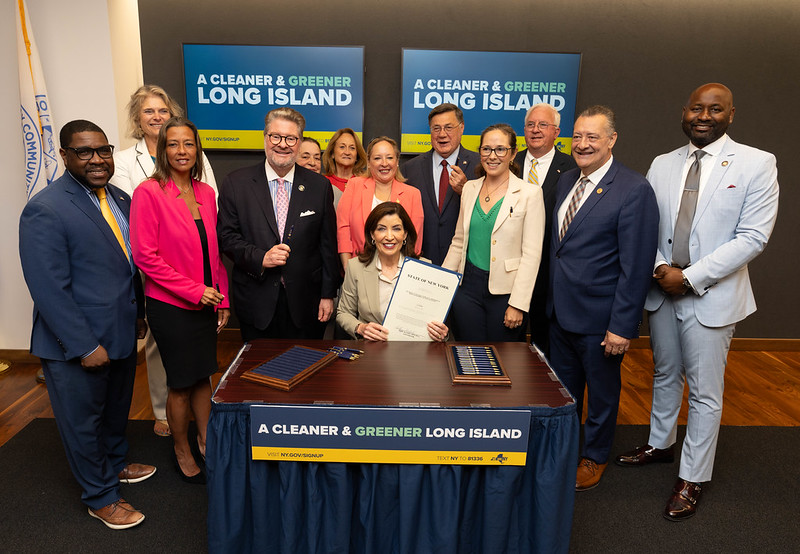You flush and forget about it. But what goes down doesn’t just disappear. On Long Island, where it ends up has been a problem for decades. Outdated septic systems and cesspools leak pollutants into the groundwater. As a result, these aging systems pose serious threats to drinking water, the environment, public health, and the local economy. It’s been a long fight for change, but on July 23rd, Suffolk County took a huge step toward cleaner water.
Governor Hochul announced $30 million in new funding and signed legislation to make it more affordable for New Yorkers to replace failing septic and cesspool systems. These upgrades to advanced systems will improve water quality across the state. “I am committed to protecting the health of all New Yorkers,” said Governor Hochul. “This bill is a promise to future generations that we will keep building a more resilient, sustainable state while ensuring clean water for all.”
These investments are part of New York’s larger push to stretch state and federal infrastructure dollars for maximum impact, delivering cleaner water, safer systems, and long-term sustainability across every region. Of the $30 million announced, two-thirds, or $20 million, will go directly to Suffolk County to help protect its sole source aquifer and surrounding waterbodies.
The New York League of Conservation Voters has long urged local leaders to take action on Long Island’s water pollution crisis, and is hopeful the state will continue building on this momentum. “Everyone deserves clean water,” said NYLCV President Julie Tighe. “The Governor’s $30 million investment is a major win for public health.”
Also in attendance were The Nature Conservancy’s New York Executive Director Bill Ulfelder and Citizens Campaign for the Environment Executive Director Adrienne Esposito, both of whom emphasized their commitment to improving New York’s water quality and reducing pollution. The event also recognized Senator Harckham and Assemblymember Kassay for pushing the bill throuygh the Legislature and advancing long-overdue wastewater solutions for Long Island.
NYLCV’s Deputy Director of Politics Casey Petrashek, who attended the signing in Suffolk County, added, “We applaud Governor Hochul, Senator Harckham, and Assemblymember Kassay for their leadership.”
The State Septic System Replacement Fund legislation complements the Long Island Watershed Program, which lays out a public, science-based plan to improve water quality, protect habitats, and engage communities in protecting the region’s groundwater.

This new law in Suffolk County builds on Governor Hochul’s historic investments in clean water. Back in May 2024, she signed the Suffolk Water Quality Restoration Act, an NYLCV Scorecard bill, to protect public health and improve water quality across the region. The law authorized Suffolk County to move forward with a ballot referendum that would fund long-term investments in wastewater infrastructure and clean water technology. It included amendments to help property owners cover the cost of installing advanced septic systems. Previously, the fund covered up to 50% of the cost, or $10,000, whichever is less. Under the new expansion, homeowners can now be reimbursed for up to 75% of the project cost, or $25,000, for systems that significantly reduce nitrogen, phosphorus, and PFAS chemicals. This addition will make the program more accessible and effective, helping to curb septic and cesspool pollution at a greater scale.
Why has Long Island struggled with water pollution for so long? The region’s water crisis stems from outdated infrastructure and unique environmental conditions. Much of Long Island relies on antiquated septic systems and cesspools, especially in Suffolk County, where centralized sewer systems are scarce. These older systems leak nitrogen, phosphorus, and PFAS chemicals directly into the ground. Since Long Island is built on sandy soil, contaminants easily seep into the sole source aquifer. This underground reservoir supplies 100% of the island’s drinking water.
Every drop that enters the groundwater flows either to a drinking water well or into nearby bays, harbors, lakes, or streams. Nitrogen pollution in the groundwater, in particular, has fueled harmful algal blooms, degraded water quality, and threatened public health and ecosystems.
This problem didn’t happen overnight. Many of these septic systems were installed decades ago, back when population density was lower and sewer infrastructure wasn’t a priority. But today, those systems are failing. Advanced septic systems are specifically designed to reduce nitrogen and can also help mitigate the impacts of pollutants. Investing in them is a critical step toward restoring Long Island’s water and protecting the communities that depend on it.
There’s been strong momentum on this issue over the past two years, but the work isn’t over. Access to clean water is a basic right, and communities across Long Island and beyond deserve safe, modern water infrastructure.
Milla Douer was a 2025 Summer Communications Intern at NYLCV. She is a fourth-year student at Cornell University, double-majoring in Environment & Sustainability and Communication. To learn more about Milla, visit https://www.linkedin.com/in/milladouer/
